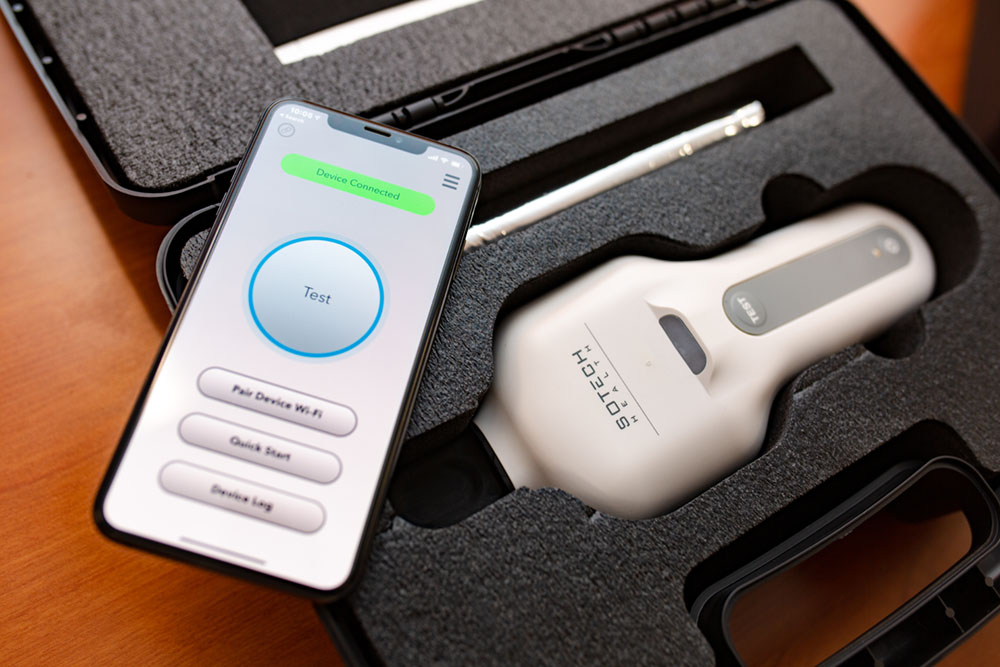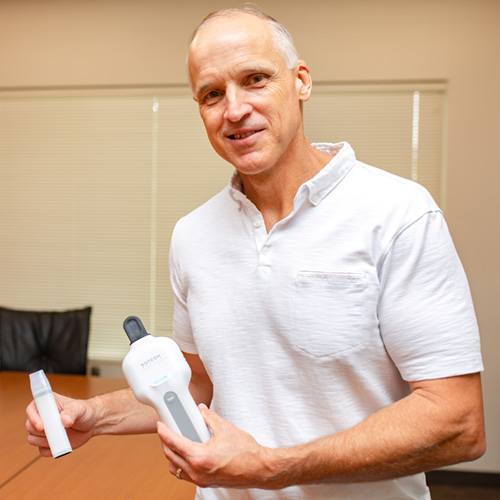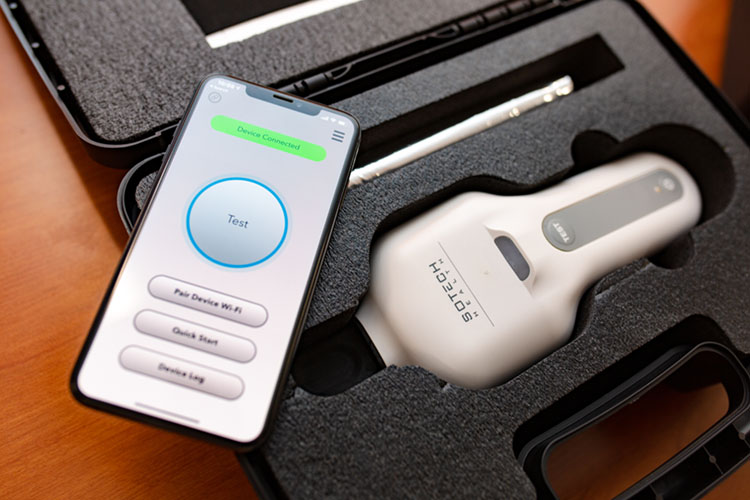
An innovative technology transfer collaboration has enabled sensor research from The University of Texas at Dallas to be leveraged into a potential rapid, at-home COVID-19 testing device.
The portable, reusable breath test device, designed to provide results in less than 30 seconds, is being developed by Dallas-based SOTECH Health, which licensed the platform technology developed by Dr. Shalini Prasad and further optimized the technology via the University’s Intellectual Property Assignment/Sponsored Research Agreement (IPA/SRA). The company has submitted the device to the Food and Drug Administration for emergency use authorization.
Prasad, department head and professor of bioengineering in the Erik Jonsson School of Engineering and Computer Science, is among the proponents of the IPA/SRA model, which provides an industry sponsor the opportunity to own the intellectual property that results from a sponsor‐funded research program.
“The roadblock typically for startups is the back and forth around who owns the intellectual property from a research project and how it is licensed. The IPA/SRA requires the university researcher to understand they are signing away the IP,” Prasad said. “SOTECH Health piloted this alternative IPA/SRA model with us, which is attractive because they own the IP — it is their asset, and they are in control of direction and messaging.”

“The sensor technology locks in to the target chemical species, causing an electrochemical reaction. The device breaks it down, which releases electrons, which in turn produce a current at a particular voltage. It’s like you’re turning a dial through radio stations.”
Dr. Shalini Prasad, department head and professor of bioengineering in the Erik Jonsson School of Engineering and Computer Science
In 2018 Prasad first discussed a partnership with Craig Micklich, the founder and CEO of SOTECH Health, who served for 13 years as a U.S. Navy SEAL. At the time, Micklich hoped to develop a sensor to locate trace markers, the volatile compounds that are characteristic of chemical explosive devices. But in March 2020, the pandemic triggered a pivot in plans.
“This electrochemical gas-sensing technology looks for volatile organic compounds in highly complex and dense environments, delivering high precision at ultra-low concentrations,” said Prasad, who is also the Cecil H. and Ida Green Professor in Systems Biology Science at UT Dallas. “To get extreme sensitivity and extreme selectivity for your target, our unique design had to have a sensing element that wasn’t impacted by the many interfering gases, or by factors like humidity and temperature changes.”
A Simple Shift
Prasad said that the shift to detecting COVID-19 infection isn’t as much of a start-from-scratch situation as it might seem. Both scenarios target very subtle chemicals — potentially 10,000 times smaller in concentration than the main components of breath or air — in an extremely complex atmosphere.
“Either way, the sensor technology locks in to the target chemical species, causing an electrochemical reaction,” she said. “The device breaks it down, which releases electrons, which in turn produce a current at a particular voltage. It’s like you’re turning a dial through radio stations. We identified specific metabolite targets and tuned the sensor to those.”

“Over the last 18 months, we have leveraged Dr. Prasad’s work to build a device we believe will be game-changing in the fight against COVID-19.”
Craig Micklich, founder and CEO of SOTECH Health
The change in targets is primarily achieved, Prasad said, through switching the substance used to coat the sensor’s interface. “There’s a lot of flexibility in designing the coating at that interface,” she said.
Micklich was impressed with Prasad’s underlying sensor technology that has formed the basis of a variety of innovative research projects, including saliva-based detection of THC levels and a real-time carbon dioxide and humidity sensor.
“Once the pandemic started, I asked Dr. Prasad if there was any way we could look at coronavirus,” Micklich said. “Within two to three weeks in April 2020, her team had designed the sensor, and we built the breath analyzer around it. Over the last 18 months, we have leveraged Dr. Prasad’s work to build a device we believe will be game-changing in the fight against COVID-19.”
Building Around a Sensor ‘Brain’
Once the sensor in the device detects gaseous metabolites that are indicative of infection with the novel coronavirus, results are delivered to the SOTECH Health cloud and companion smartphone app. Individuals who test positive are directed to get a standard COVID-19 test for confirmation.
“A cloud-based AI records anonymized analytics for health care professionals and public agencies to track results in a way that will help focus outbreak management efforts where they are most needed,” Micklich said.
Kade France, SOTECH Health’s chief technology officer, described how the company’s technology team converged on a hand-held solution backed by an artificial intelligence platform to make the best use of the information the sensor provides.
From Lab to Market
The Office of Technology Commercialization works with UT Dallas researchers and external partners to bring the fruits of UT Dallas innovation to the public through commercialization. Learn more about its resources on its website.
“Dr. Prasad’s incredible technology provides many capabilities,” France said. “Our team compressed that technology, rebuilt a motherboard, built a mechanical enclosure around it — all to make it portable and user-friendly. We included sensors for temperature and humidity as well as communication sensors that allow the device not only to transmit its results, but also to update itself like a smartphone does.”
Two main factors necessitate such updates: drift, which occurs as a sensor’s response gradually changes over time, and the evolution of the variants of SARS-CoV-2, the virus that causes COVID-19. SOTECH’s AI provides an all-seeing eye over all of the data that is accumulated among devices. This “always-on” system provides tight quality control over each device while also interpolating potential trends in the behavior of the virus.
“Our autonomous quality control system compensates for drift to hone specificity and sensitivity in what the sensor is measuring,” France said. “Data is uploaded to an always-on cloud, where machine-learning software analyzes the information and refines our thresholds.”

“That’s why UTD’s novel IPA/SRA model has been so attractive to many industry sponsors — by giving them ownership of the IP, it eliminates the risk and uncertainty around license negotiations and the subsequent financial obligations.”
Brent Schultze, director of technology commercialization at UT Dallas
Prasad described it simply: “If the sensor is the brain, SOTECH Health had to build the body around that brain.
“The sensor by itself cannot make an accurate prediction. The rest of the breath analyzer device takes this small electrochemical signal, takes into account the environment and runs that through algorithms to give a very accurate reading. All this engineering around it creates a portable, accurate product.”
Armed with this technology, SOTECH Health received a Work Package I grant from the Center for Advancing Point of Care Technologies as part of the National Institutes of Health’s Rapid Acceleration of Diagnostics initiative, launched in April 2020 to accelerate development of COVID-19 testing technology.
Innovative IP
SOTECH Health worked extensively with Steve Guengerich, UT Dallas’ associate vice president for innovation and commercialization, and Brent Schultze, the University’s director of technology commercialization. For two years, SOTECH Health has been located at the University’s Venture Development Center, a corporate incubator facility on campus with 20,000 square feet of office, lab and meeting space to facilitate the growth of ventures founded by faculty, staff, students and alumni.
Schultze said that the University’s IPA/SRA model is one of only a few nationwide, and that the popularity of the model, with nine deals executed in the past two years, speaks to the quality of the research taking place at UT Dallas.
“In technology transfer, the typical approach is that if a company wants to utilize the intellectual property that results from a research project they funded, they have to negotiate a license from the university. Many industry sponsors find that arrangement less than ideal,” he said. “That’s why UTD’s novel IPA/SRA model has been so attractive to many industry sponsors — by giving them ownership of the IP, it eliminates the risk and uncertainty around license negotiations and the subsequent financial obligations.”
Micklich described the IPA/SRA as a perfect model for his company.
“Normally, if you create follow-up technologies out of an original platform, it can create problems. Instead, we have this novel licensing agreement,” he said. “I think it’s very appealing to most entrepreneurs who want to work with universities.”
Prasad said she believes such agreements open doors for the fast-growing biotechnology industry in North Texas.
“Texas is very business-friendly; a lot of startups come here and originate here,” she said. “Since the IPA/SRA model has been green-lit, local industry has been very interested in using this. Once we demonstrate this successful partnership with SOTECH Health, there should be even more interest. We are also making our graduates more industry-ready, so we are meeting the larger mission for the University. That’s a big success story.”
